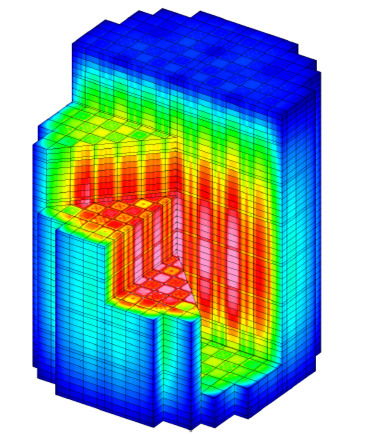Shadowcaster overview
VERA (Virtual Environment for Reactor Applications) is an integrated high-fidelity simulation framework developed under the U.S. Department of Energy’s Consortium for Advanced Simulation of Light Water Reactors (CASL) program. It provides a multiphysics environment that couples neutron transport, thermal-hydraulics, fuel performance, and chemistry models for comprehensive light-water reactor (LWR) analysis.
At the core of VERA is MPACT, a 3D whole-core neutron transport and depletion solver. MPACT employs a 2D/1D method, which combines a two-dimensional Method of Characteristics (MOC) solution in the radial plane with a one-dimensional P₃ approximation in the axial direction. The two solvers are coupled through axial leakage and accelerated using a coarse-mesh finite difference (CMFD) scheme. MPACT dynamically generates multigroup cross sections using the subgroup method and performs depletion calculations in conjunction with ORIGEN. Within the broader VERA framework, MPACT is tightly coupled with CTF (subchannel thermal-hydraulics), BISON (fuel performance), and MAMBA (CRUD chemistry) to perform fully coupled multiphysics reactor simulations.
Application to the NETL TRIGA Mk-II Research Reactor
Using this framework, MPACT has been applied to simulate the operational behavior of the NETL TRIGA Mk-II reactor at The University of Texas at Austin. Unlike continuously operated power reactors, the NETL TRIGA operates for approximately 4–8 hours per day, undergoing a complete startup and shutdown sequence daily. This operational pattern provides a unique opportunity to study and calculate reactor characteristics such as initial critical rod height, temperature feedback, and xenon concentration with high temporal resolution.
As an initial effort, MPACT was configured to predict the initial critical rod height for the next day’s startup based on the reactor’s daily operating history. After the reactor’s core configuration was finalized in January 2025, the model began ingesting each day’s operational log as input and generated predictions for the next day’s critical rod position. The reference prediction time was set to 8:30 a.m. of the following day. Using operational data accumulated through June 2025, a bias-correction model was constructed to improve the accuracy of the MPACT-based predictions.
For more details, please refer to the official MPACT website.
